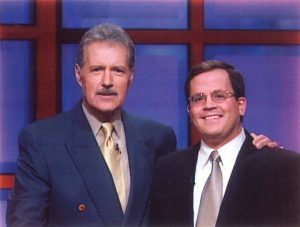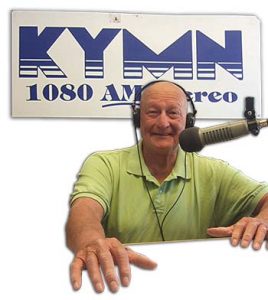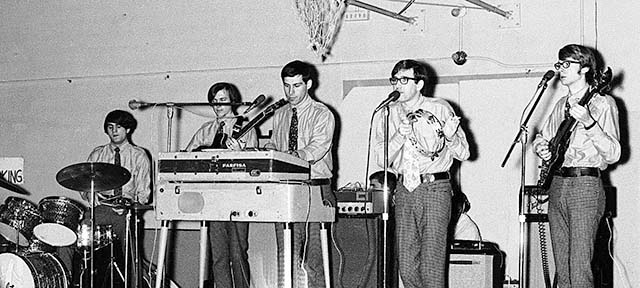
Way back in the historic mid-1960s, when I was attending St. Olaf, my friends and I would head down to Sayles-Hill Gym at Carleton to attend dances. St. Olaf had only allowed dancing on campus since 1961 (except for square dancing, called “square gaming” back then so no one would think Oles were actually engaged in dancing) and the early “officially approved” Ole dances were pretty lame. Carleton had allowed dancing since 1918 and you could count on the socially advanced Carls to put on great dances with great bands.
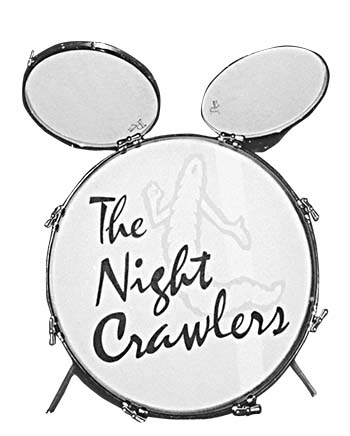 And absolutely the best dance band at Carleton and in southern Minnesota during the 1960s was a group known as the Night Crawlers. Oles, Carls and townies alike flocked to their dances and bought the 45 rpm singles of their original song “You Say,” which we all played on old-fashioned contraptions called record players.
And absolutely the best dance band at Carleton and in southern Minnesota during the 1960s was a group known as the Night Crawlers. Oles, Carls and townies alike flocked to their dances and bought the 45 rpm singles of their original song “You Say,” which we all played on old-fashioned contraptions called record players.
The genesis for this band was Owatonna, long before Adam Young of “Owl City” fame. Jim Oldsberg, in his 1992 book, “The Flip Side: An Illustrated History of Southern Minnesota Rock & Roll Music from 1955-70,” traces a shifting evolution from three ninth grade schoolmates at Owatonna High School playing for mixers in the cafeteria to other combinations of members, with the focal point being Marc Reigel on piano.
Reigel tells me that his father, Donald (a 1936 graduate of Carleton and publisher of the Owatonna Photo News from 1956-74), was an accomplished pianist. Reigel played trombone in band and orchestra, but taught himself piano by playing along with 45 rpms of Fats Domino, Ricky Nelson and Buddy Holly. By his senior year, he had formed the “OHS Combo,” playing at mixers after football and basketball games.
When Reigel went to Carleton, in the fall of 1963, he would go to the third floor of Willis Hall where there was an “old, out-of-tune, upright piano” and just “pound away,” as he says, playing hits by such artists as Chuck Berry, Elvis, the Everly Brothers and the Shirelles. Often the “noise” attracted a few students who joined in the singing. By 1964-65, he had a five-piece group called the Mark II’s, so-named because his classmate Mark Headington of Minneapolis had joined in on bass. They got a “couple of paying gigs at Sayles-Hill Gym,” now the campus center, and were pictured in the 1965 Algol yearbook, juxtaposed with a photo of the well-known pianist, Van Cliburn, who had played at Carleton that year. Reigel says: “The irony was not lost on us, even as 20-year-olds!”
The Mark II’s were a popular addition to the campus dance scene but by the summer of 1965, only Marc and Mark remained of that group. Back home in Owatonna, Reigel heard a band called “The Checkmates” and swooped in on two Owatonna High School students, guitarist Mike Jines and drummer Bill Redeker. He asked them to form a new band with him. That summer the lore is that Headington had a dream about large worms, which inspired the name for the band: the Night Crawlers. The Night Crawlers debuted at a “Battle of the Bands” at the Steele County Free Fair in August of 1965 and won. Northfielder Tim Sellers recalls watching that performance and tells me he got “goose bumps” hearing them play Dylan’s “Like a Rolling Stone.” Their winning song was “Silver Threads and Golden Needles.”
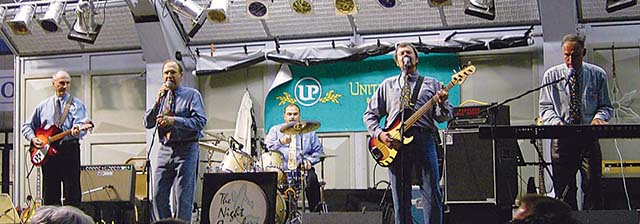
The Night Crawlers were completed when Barry Gillespie, also of Owatonna, was recruited as the lead singer in February 1966. The group’s growing popularity led to their being represented by promoter Don Madison and to a recording session for MAAD Records in Mankato. Here they cut two original songs, “You Say,” by Barry Gillespie and his former bandmate Sid Gasner, and “Night Crawlin,’” an instrumental which Reigel says he and Headington “hurriedly composed” just ten minutes before it was recorded when they realized they “needed an original B-side.”
Oldsberg writes that the recording session cost $300, “which entitled the group to the recording time and a record pressing of 1000 copies. Barry received four cents a copy for his composition and Reigel and Headington each received two cents per copy for their Night Crawlin’ contribution. They sold enough records at Carleton to basically break even. Other regional sales produced a small profit for them.” Reigel remembers selling the records at Carleton for a dollar in the basement of Willis Hall, four flights down from the “rickety piano” he had pounded on as a freshman.
The Night Crawlers played on the southern Minnesota/Iowa “sock-hop” circuit, with a couple forays to North Dakota. After a gig in Estherville, Iowa, they were traveling back to Minnesota in a big Oldsmobile sedan, towing a U-Haul loaded with their equipment. A 1957 Chevy filled with “greasers” pulled them over and tried to get them to play at a party that night. When this idea was rejected, one of the greasers told them he had a gun and asked for their money. Gillespie could only think to push in a cigarette lighter in the dashboard as a possible weapon, while Headington, who was at the wheel, floored the Olds. After an eight-mile chase and a bump from the Chevy, Headington signaled to make a left turn, then turned quickly to the right, thus faking out the pursuers, who flew by to the left. The band made it to a small town and, says Reigel, “found the local cop, waiting for speeders on the main street, and breathlessly reported the near-disaster.”

Then, to the band’s chagrin, their promoter Madison booked them in Estherville again six weeks later because, he said, “They loved you down there!” An armed guard was promised to allay any fears. So, on the return engagement, Reigel took note of the greasers in the audience and couldn’t resist taunting them a bit. This led to a confrontation in the men’s bathroom later, broken up by the club’s owner – and, says Reigel, “a lot less taunting!” After the performance, the band was escorted to the Minnesota border by the police.
Madison arranged another recording session for the band in 1966 at Columbia Records in Chicago. Acetates of a cover of Johnny Preston’s “Feel So Fine” and an original, fuzz-busting guitar/vocal called “Want Me” were made, though no records resulted at that time. But “Want Me” can now be found in two compilations: “Get Off My Back!: Unissued Sixties Garage Acetates” and “Back from the Grave,” a development that Reigel considers “serpentine,” wondering, “How did those acetates get there?”
Their recording of “You Say” went on to have significant air play in Chicago, even after the band disbanded. Reigel was teaching in the Chicago area and his students rallied behind this Byrds-like classic, featuring strong vocals and Mike Jines on his 12-string guitar. Their support drove it up to number one on WEEF’s North Shore Top Ten, ahead of songs by the Rolling Stones, Neil Diamond, the Box Tops and the Young Rascals. As Oldsberg wrote, “Unfortunately the demand was not followed up by a supply of records to the area.” In 1996, Headington corresponded with Byrds’ leader Roger McGuinn and got his autograph on the band’s copies of “You Say.”
The popularity of this band can be judged by their income from playing about eight shows a month during the senior year of Reigel and Headington – $10,000, or $70,000 in today’s money. Reigel says, “That’s a lot of buck-fifty gigs.”
The band played a four-hour farewell dance at Carleton in June of 1967, as Reigel and Headington were graduating. The performance, which was transferred from tape to a four-CD set, showcases their versatility, with more than 50 songs including the Beatles, of course, and Dave Van Ronk’s “Cocaine Blues,” Howling Wolf’s “Smokestack Lightning,” Martha and the Vandellas’ “Heat Wave,” the Shirelles’ “Baby, It’s You,” Wilson Pickett’s “Midnight Hour,” the Turtles’ “Happy Together,” “The Girl from Ipanema” and their own originals, “Want Me” and “You Say.” There is even a medley of classics “Louie Louie” and “Hang On, Sloopy,” with “Jesus Loves Me” thrown in.
 The 1967 tape was called “Last Dance,” but Carleton was not ready to let them go: the Crawlers were hired for a dance at Sayles-Hill in January 1968. Reigel says they had to borrow all of the equipment from “the guys to whom we had sold it the past spring.” The reviewer in the Carletonian of Jan. 11 wrote, “The veteran ‘Night Crawler’ fans were ecstatic; the newer ones were overwhelmed.” The band (minus Redeker) then reunited for the 25th reunion of Carleton’s Class of 1967 in 1992. They also played at two reunions in Owatonna, with Reigel’s son David on drums – for the town’s sesquicentennial in 2004 and an all 60’s high school class reunion in 2006, both held at the Steele County Free Fairgrounds. Reigel and Headington were invited to entertain at yet another class reunion, this time the 35th reunion of Carleton’s class of 1969, held at the Grand Event Center in Northfield in June of 2004. Then, on May 1 of this year, Reigel, Headington and Gillespie (with the assistance of Reigel’s son-in-law, Tom Wadzinski) reunited at Froggy Bottoms River Pub, rocking the frog pond before a cheering, standing-room-only crowd.
The 1967 tape was called “Last Dance,” but Carleton was not ready to let them go: the Crawlers were hired for a dance at Sayles-Hill in January 1968. Reigel says they had to borrow all of the equipment from “the guys to whom we had sold it the past spring.” The reviewer in the Carletonian of Jan. 11 wrote, “The veteran ‘Night Crawler’ fans were ecstatic; the newer ones were overwhelmed.” The band (minus Redeker) then reunited for the 25th reunion of Carleton’s Class of 1967 in 1992. They also played at two reunions in Owatonna, with Reigel’s son David on drums – for the town’s sesquicentennial in 2004 and an all 60’s high school class reunion in 2006, both held at the Steele County Free Fairgrounds. Reigel and Headington were invited to entertain at yet another class reunion, this time the 35th reunion of Carleton’s class of 1969, held at the Grand Event Center in Northfield in June of 2004. Then, on May 1 of this year, Reigel, Headington and Gillespie (with the assistance of Reigel’s son-in-law, Tom Wadzinski) reunited at Froggy Bottoms River Pub, rocking the frog pond before a cheering, standing-room-only crowd.
Redeker last played with the band in 1968. As he told me in a recent e-mail, “The breakup of the Crawlers drove me to the desert of Arizona, another band and a college education.” In his senior year, Redeker “convinced the general manager of a television station to hire me as a technical director. I quickly switched to reporting and eventually put in 35 years as a network news correspondent for ABC and CBS.” Redeker, who is a six-time Emmy-winner, jokes that his résumé reads like “holidays from Hell” with tours of every war zone from South East Asia to Africa, Central America and the Middle East. He was also posted in Tokyo, Los Angeles, New York, London, Washington, D.C., Jerusalem, Tel Aviv and Denver. He says, “Sadly the grind kept me from participating in Night Crawler reunions.” He recently left the news business and now develops and sells mountain properties in Park City and Deer Valley, Utah, “where skiing has replaced the thrill of performing…sort of.” Yet, he writes, he still has his Rogers drums. “They look terrific and sound pretty good. I’ve sat in with bar bands in Mexico and Japan but that’s about all. Would love to play one last dance with the Crawlers someday.” When three of the Night Crawlers reunited on May 1, Redeker sent the drum head with their band logo to Northfield as a surprise.
Band leader Marc Reigel taught high school English for five years in Highland Park, Illinois, and earned an M.A. in American Literature at Northeastern Illinois University in Chicago. He then taught English at Edina East High School 1972-80. He was Dean of Students at Edina’s Valley View Junior High School 1980-81 and after two years teaching in Rochester, he again taught at Edina High School from 1983-88 and was staff development chair for the district. Since 1988, Reigel has lived in Columbus, Ohio. While at the Ohio Dept. of Education, his book, “Image to Impact: Toward Excellence in Teaching” was published in 1990. Reigel now works with school districts, “writing grants, conducting assessments, and running in-service programs for teachers and administrators.” He also volunteers as a blood courier for the American Red Cross, drives Meals on Wheels and writes program notes for Six String Concerts in Columbus.
Reigel’s Carleton classmate, Mark Headington, headed to the University of Iowa for an M.S. in computer science. He then developed software and taught in universities in Minneapolis, East Africa, Washington, D.C., Illinois, and Wisconsin. After earning a Ph.D. from Iowa State, he had teaching positions in Iowa, California and again in Wisconsin, where he is a now a professor at the University of Wisconsin-La Crosse. He is co-author of 12 university-level computer science textbooks. While at the University of Iowa, he engaged in some folk and Mississippi Delta blues solo work but then left music for 25 years. A 1992 reunion performance with the Crawlers “reawakened the need to make music,” he says. He has played in several rock and blues bands in LaCrosse: the Exchequers, LB and the Biscaynes and the Shufflin’ Duprees. He says he is “currently between bands” or “retired from music – I can never be sure!”
Lead singer Barry Gillespie continued to sing after the Night Crawlers broke up but settled into the real estate business, as a third generation owner of ERA-Gillespie Real Estate in Owatonna (his sister, Pam Gillespie, works for Edina Realty in Northfield). Gillespie was named Minnesota Realtor of the Year in 2002 and served as president of the Minnesota Association of Realtors 2002-03. He tells me his father Lud still has the best voice in the family, at age 85.
Mike Jines, a Northfield resident, says he mostly retired from the violin (his first love) and guitars after 1967; he then stopped completely after an unfortunate “incident with a power saw.” For 37 years, he has been a design engineer, mostly in new product development and has worked for Wenger Corporation of Owatonna for almost 24 years. Jines designs equipment used for music education and performance. He says, “I frequently visit rehearsal and concert spaces and hear the students performing. It helps me feel connected to music – if only indirectly.”
I asked all of the Night Crawlers for their favorite memories.
Reigel recalls their winning performance in 1965 at the Steele County Free Fair “Battle of the Bands” in front of 3,000 kids (“much to the chagrin of the Emperors,” he notes), and the Iowa car chase story. Also, he remembers playing prom dances for kids in small towns all over southern Minnesota who “would always be dressed up, just love the music, and seem so archaically innocent” (no matter what might happen after the dance!).
Jines’ favorite memories involve playing at Carleton, before the big, friendly and enthusiastic crowds of Carls, Oles and townies. He also remembers one “seriously impaired Ole” who did not like a medley which combined “Louie Louie” with “Jesus Loves Me.” Jines says, “Remembering the irony of his drunken scolding always makes me laugh.”
Headington agrees with Jines about the Carleton dances. “With the crowds so fired up and supportive, it was just a thrill to be part of the rhythm and spirit. Also, I have such a strong memory of how satisfying it was to be part of a group of good musicians. Marc would decide we should play a new song, but we were living in different towns and couldn’t find time to practice together. So we’d all learn our parts separately, and at the next dance we would just play the song for that first time together. And it worked! I don’t think many bands at that time could get away with that.”
Redeker says, “No doubt about it, Carleton is at the top of the list. The enthusiastic feedback of the crowd energized us and cranked up our performances. Bill’s Pizza, townies, Oles and road trips are all fond memories.” The best memory is “the energy created when the five of us somehow made it all work. It was infectious, exhilarating and loud!” Redeker also puts in a word of praise for their supportive parents and for Reigel: “The Crawlers had a lot of spirit, thanks to the energetic leadership of Marc.”
Gillespie also recalls the “rush” when a crowd was big and supportive. “When things really got going it was a thrill.” The recent reunions of the band “have been amazing, with the crowd (aging by the minute) excited and appreciative from start to finish. People do like to recapture what they remember as the ‘good old days.’ And so do we.”

Let’s let the band’s leader Reigel have the last word (of course). The Last Dance of 1967 is one of his favorite memories. But, “It was clear this part of our lives was coming to an end, and – truth be told – just about the right time.” The music was changing from the “melodic, danceable, infectious, sing-along-to-able” to the “psychedelic, metal, thrash kind of music,” which signaled the “death knell of sock-hops.”
The Night Crawlers were a cover band, with a couple originals and, Reigel says, “To make a real ‘go’ of it in the music business, you have to be the Beatles, not copy the Beatles. Perhaps we had the talent to come up with some, but it sure didn’t feel like we had the time or inclination.”
Reigel still likes to strum guitar along with music (“still covering, after all these years!” ) and will sit down at a “stray piano and plunk.” He says that although the days of wine and roses are gone, “the days of still loving music, attending concerts, buying music, strumming along, are still with us!”
My thanks to all the Night Crawlers for sharing their memories with me: Marc, Mark, Barry, Mike and Bill. Rock on, guys! Thanks also to Carleton archivist Eric Hillemann, Jim Oldsberg and Erika Van Buren.
New Day for Night Crawlers
The Night Crawlers now have a whole new fan base, thanks to the Internet, in particular the social networking site called Facebook. About ten years ago, Erika Van Buren, a Netherlander who grew up in Japan, was an amateur teenage guitarist in Japan. She auditioned a female vocalist who brought along a cassette tape of her favorite songs. On this tape was “You Say” by the Night Crawlers of Owatonna, Minn. Van Buren e-mailed me, “As soon as I listened to it, I was totally blown away and attracted to this wonderful tune. The cool fill-in of the drums, endless jangling electric 12-string guitar, crisscrossing running bass and bitter-sweet melody, but still full of raw and powerful impetus. Everything was perfect to me!”
So how did “You Say” end up in Japan? Van Buren thinks it came from a garage-punk compilation LP called “Pebbles, Vol. 17.” She ultimately obtained the same 45 rpm original from MAAD Records that I bought at a Carleton dance years ago. She told me, “U.S. garage punk or garage rock from the 60s has quite a large fan base all around the world.” Mike Jines’ guitar work on this piece “is prominent enough to attract 12-string lovers” and she believes “it still has some kind of potential to attract more people even today – 44 years after its first release.”
Van Buren (who is in her late 20s and is engaged in the food trading business) creates and administers a number of pages and groups devoted to music. In April she established a Facebook fan page for the Night Crawlers. The site features photos, videos, links to songs and publications and a running commentary from fans.
Reigel, who co-administers the site, reports there are fans from the United States, France, Greece, Italy, Japan, Sweden, Malaysia, Bulgaria, Canada, Germany, Taiwan, Spain and the United Kingdom. Alexandre Hussenet of France is a super-fan of the Night Crawlers, a member of what he calls a “little niche of people in Paris” who are “garage obsessives.” A musician from Glasgow tells Reigel, “I adore your music, man. You have been an influence on my own music and will continue to be.”
As Reigel is fond of saying, “You can’t make this stuff up!”


